German actor Otto Gebühr (1877-1954) appeared in 102 films between 1917 and 1962. He is best known for his interpretation of Friedrich II (Frederick the Great), a role he played in 16 films and countless stage performances. He was one the most famous actors of the Weimar period, and thanks to his authoritative roles the Nazis gave him the title 'Actor of the State'.
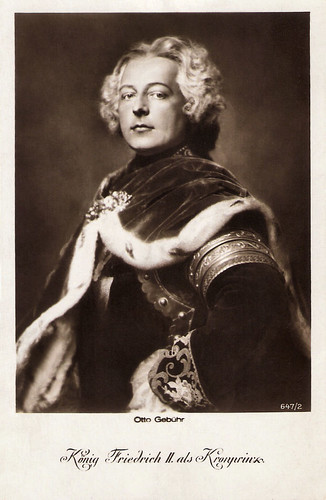
German postcard by W.J. Morlins / Ross Verlag, no. 647/2. Photo: Karl Schenker. Publicity still for Fridericus Rex (Arzén von Cserépy, 1921). Fridericus Rex was a four-part series with Otto Gebühr as King Frederick II as Crown Prince in part I and II.
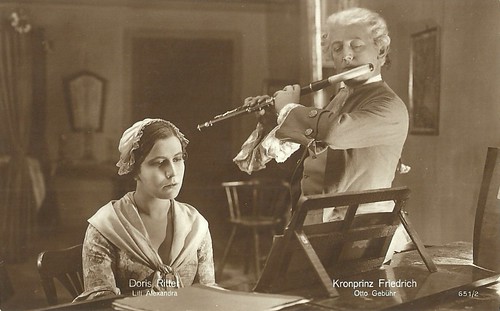
German postcard by Ross Verlag, no. 651/2. Otto Gebühr as crown prince Frederick (future Frederick II) and Lilly Alexander as Doris Ritter in Fridericus Rex (Arzen von Cserépy, 1921-1922).

German postcard by Ross Verlag. Photo: Fox. Otto Gebühr as King Frederick the Great in the German silent film Die Mühle von Sanssouci/The Mill of Sanssouci (Friedrich Zelnik, Siegfried Philippi, 1926).
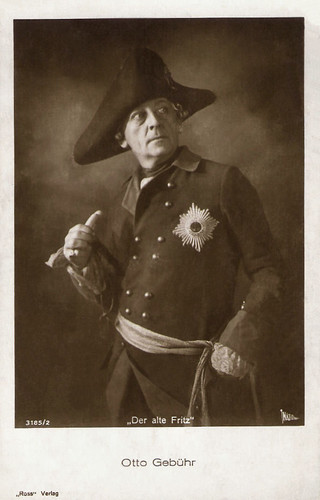
German postcard by Ross Verlag, no. 3185/2, 1928-1929. Photo: National. Publicity still for Der alte Fritz/The Old Fritz (Gerhard Lamprecht, 1928).
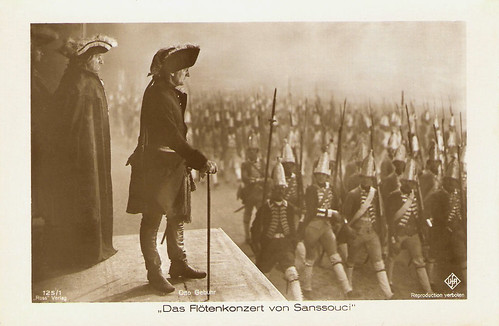
German postcard by Ross Verlag, no. 125/1. Photo: Ufa. Otto Gebühr as Frederick the Great in Das Flötenkonzert von Sanssouci/The Flute Concert of Sans-Souci (Gustav Ucicky, 1930).
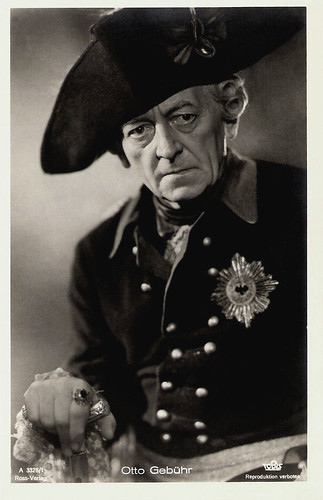
German postcard by Ross Verlag, no. A 3326/1, 1931-1944. Photo: Tobis. Publicity still for Der große König/The Great King (Veit Harlan, 1942).
Otto Gebühr was born in Kettwig (now Essen), Germany in 1877. He was the son of merchant Otto Gebühr and his wife Fanny Mathilde Moll. He grew up in Hülsenbusch, a part of Gummersbach, and, after his father’s death, in Köln (Cologne).
After attending grammar school he had a trade training at a wool firm. In 1896 he worked as a correspondent in foreign languages for a firm in Berlin, but he also had acting classes. For a while, he then worked as a strolling actor till he got a contract at the Stadttheater Görlitz.
From 1898 to 1908, he worked at the Königlichen Hoftheater in Dresden, and till 1914 at the Lessingtheater and the Theater in der Königgrätzer Straße, both in Berlin. During the First World War, he was an army volunteer for the field artillery regiment and became a second lieutenant. After this, he worked from 1917 to 1919 for famous director Max Reinhardt at the Deutschen Theater in Berlin.
At the same time, he began to appear in silent films. His film debut was Der Richter/The Judge (Hans Land, 1917) for the Messter company. Gebühr was a look-a-like of King Friedrich II (1712-1786). Introduced by his colleague Paul Wegener, director Carl Boese cast him as the King of Prussia in the silent film Die Tänzerin Barberina/The Dancer Barbarina (Carl Boese, 1920). The role would become his breakthrough. He would play Friedrich several times, but initially in the very successful, four-part film series Fridericus Rex (1920-1923).
To his other well-known silent films belong the crime film Whitechapel (Ewald André Dupont, 1920), the worldwide success Der Golem, wie er in die Welt kam/The Golem: How He Came Into the World (Carl Boese, Paul Wegener, 1920), Wilhelm Tell (Rudolf Dworsky, Rudolf Walther-Fein, 1923), Die Perücke/The Wig (Berthold Viertel, 1925), Die Gesunkenen/The Sunken (Rudolf Walther-Fein, Rudolf Dworsky, 1925), and Waterloo (Karl Grune, 1929).

German postcard by Ross Verlag, Berlin, no. 651/4, sent by mail in 1922. Photo: Cserépy-Film Co. Still for Fridericus Rex (1921).

German postcard by Ross Verlag, Berlin, no. 651/8, sent by mail in 1922. Photo: Cserépy-Film Co. Still for Fridericus Rex (1922) with Lili Flohr.

German postcard by Ross Verlag, no. 51/9. Photo: Fox. Otto Gebühr as King Frederick the Great in Die Mühle von Sanssouci/The Mill of Sanssouci (Friedrich Zelnik, Siegfried Philippi, 1926).
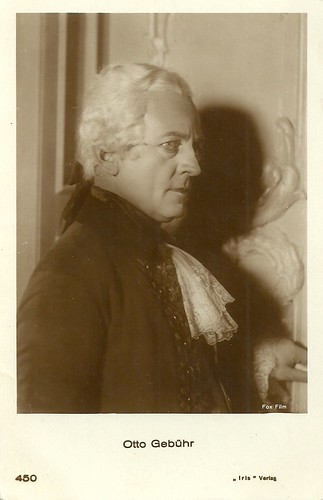
Austrian postcard by Iris Verlag, no. 450. Photo: Fox Film.
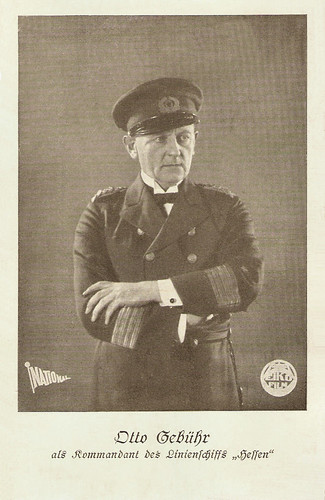
German postcard by Eiko Film / National-Film A.G., Berlin. Photo: Eiko Film / National. Publicity still for In treue stark/In faithful strong (Heinrich Brandt, 1926). Caption: Otto Gebúhr as commander of the Line Ship Heffen.
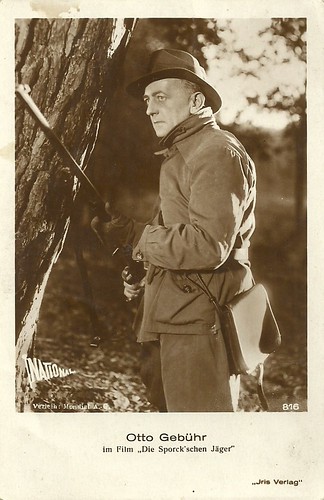
Austrian postcard by Iris Verlag, no. 816. Photo: National Film / Mondial AG. Otto Gebühr in the German silent film Die Sporck'schen Jäger (Holger-Madsen, 1926).
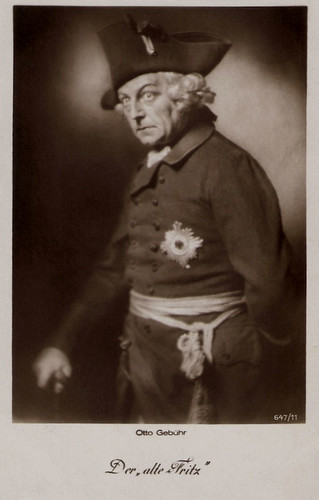
German postcard by W.J. Morlins, Berlin / Ross Verlag, Berlin, no. 647/11. Photo: Karl Schenker / Cserépy-Film Co. Otto Gebühr as Friedrich II in Der Alte Fritz/The Old Fritz (Gerhard Lamprecht, 1928).
After the introduction of the sound film, Otto Gebühr again had a huge success as the King of Prussia in Das Flötenkonzert in Sanssouci/The Flute Concert of Sans-Souci (Gustav Ucicky, 1930). He repeated his role in the remake of Die Tänzerin von Sanssouci/Barberina (Friedrich Zelnik, 1932) at the side of Lil Dagover and Hans Stüwe.
Gebühr was the cinematic incarnation of the heroic Prussian, and his type was popular during the Third Reich. Gebühr was a voluntary pawn in the propaganda machine of the Nazis and appeared in several films, including Fridericus (Johannes Meyer, 1937) with Lil Dagover, as the ‘First National Socialist’, as propaganda minister Joseph Goebbels had called him.
In 1938 Goebbels gave Gebühr the title 'Staatsschauspieler' (Actor of the State). He was then one of the four highest-paid and most famous actors in Germany - the others were Heinz Rühmann, Hans Albers and Heinrich George. Among his entertainment films were big hits such as Der Choral von Leuthen/The Anthem of Leuthen (Carl Froelich, Arzén von Cserépy, 1933) with Olga Tschechova, Nanon (Herbert Maisch, 1938) with Johannes Heesters, and Casanova heiratet/Casanova Marries (Viktor de Kowa, 1939).
Some of his roles, like Blücher in Waterloo (Karl Grune, 1928) and the King of Saxony in Bismarck (Wolfgang Liebeneiner, 1940), had the same authoritative features as Friedrich II. He again appeared as Friedrich II in Veit Harlan’s epic Der große König/The Great King (Veit Harlan, 1942).
Till the end of the Third Reich, he appeared in more light entertainment films like Immensee (Veit Harlan, 1943) starring Kristina Söderbaum and Carl Raddatz, Die goldene Spinne/The Golden Spider (Erich Engels, 1943), and Der Erbförster/The Hereditary Forester (Alois Johannes Lippl, 1945).
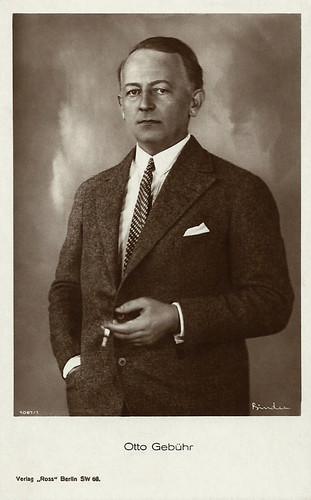
German postcard by Ross Verlag, no. 1067/1, 1927-1928. Photo Alex Binder.
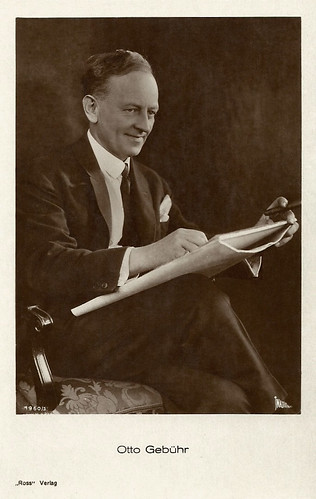
German postcard by Ross Verlag, no. 1960/1, 1927-1928. Photo: National.
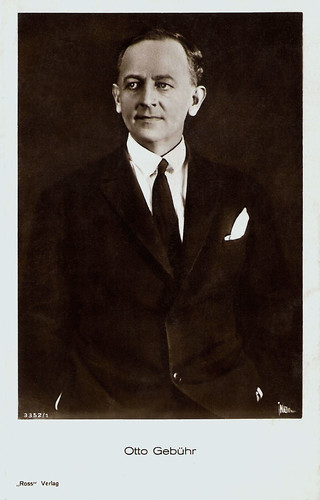
German postcard by Ross Verlag, no. 3352/1, 1928-1929. Photo: National.
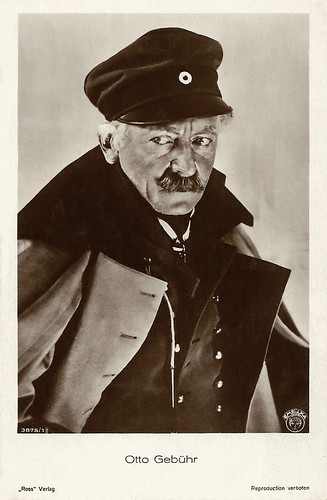
German postcard by Ross Verlag, no. 3875/1, 1928-1929. Photo: Emelka. Publicity still for Waterloo (Karl Grune, 1928), in which Gebühr played General/Fieldmarshall Blücher and Frederick the Great. Here he is dressed as Blücher.
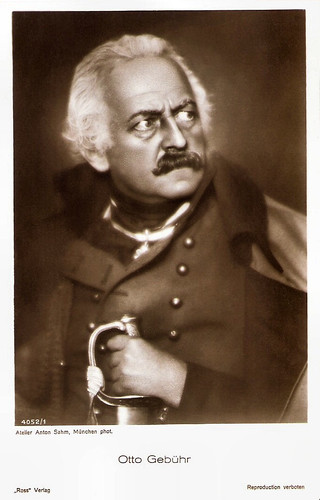
German postcard by Ross Verlag, no. 4052/1, 1929-1930. Photo: Anton Sahm, München.
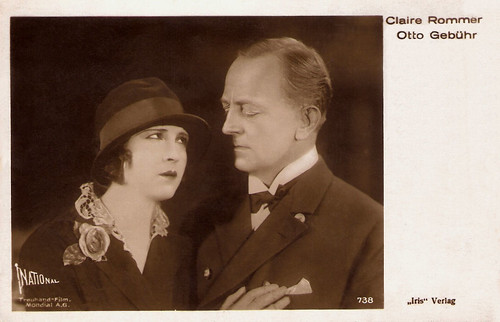
Austrian postcard by Iris Verlag, no. 738. Photo: Treuhand-Film / Mondial A.G. / National. Publicity still for Scapa Flow (Leo Lasko, 1930) with Claire Rommer.
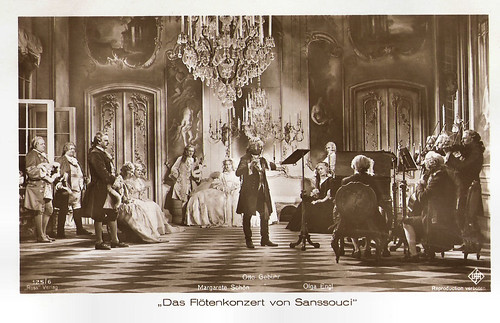
German postcard by Ross Verlag, no. 125/6. Photo: Ufa. Otto Gebühr as Frederick the Great in Das Flötenkonzert von Sanssouci/The Flute Concert of Sans-Souci (Gustav Ucicky, 1930). This picture is a literal citation of the famous painting Flötenkonzert Friedrichs des Großen in Sanssouci (1850-52) by Adolph (von) Menzel, now at the Alte Nationalgalerie in Berlin.
From 1947 on, Otto Gebühr was permitted to work again in the theatre. His first post-war film was the drama ...und über uns der Himmel/...and the Sky Above Us (Josef von Báky, 1947) starring Hans Albers.
Till his death, he appeared in many entertainment films. He often played the odd companion or the cheerful senile maverick in such Heimatfilms as Melodie des Schicksals/Melody of Destiny (Hans Schweikart, 1950) with Brigitte Horney, and Grün ist die Heide/The Heath Is Green (Hans Deppe, 1951) starring Sonja Ziemann and Rudolf Prack.
Again he also appeared under the direction of Veit Harlan in Unsterbliche Geliebte/Immortal Beloved (1951) with Kristina Söderbaum.
His final film was Die Blonde Frau des Maharadscha/The Blonde Wife of the Maharadja (Veit Harlan, 1962) – a new version of Die Gefangene des Maharadscha/Circus Girl (Veit Harlan, 1954). The film was released eight years after his death.
Otto Gebühr died of heart failure in 1954, in Wiesbaden, Germany. He was twice married. In 1910 he married Cornelia Bertha Julius, with whom he had a daughter, actress Hilde Gebühr. His second wife was actress Doris Krüger, with whom he was married from 1942 till her death in 1950. They had a son, Prof. Dr. Michael Gebühr.
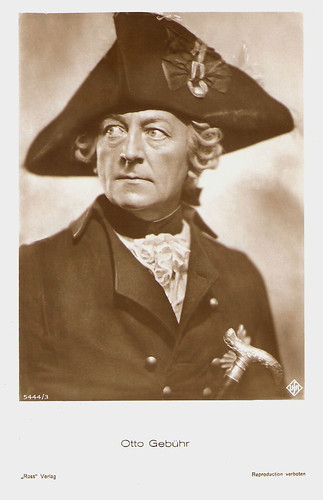
German postcard by Ross Verlag, no. 5444/3, 1930-1931. Photo: Ufa. Otto Gebühr as Friedrich II in Das Flötenkonzert von Sanssouci (Gustav von Ucicky, 1930).
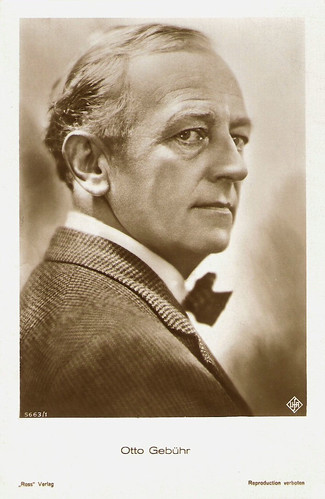
German postcard by Ross Verlag, Berlin, no. 5663/11, 1930-1931. Photo: Ufa.
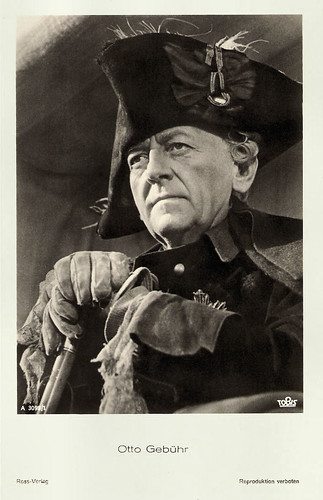
German postcard by Ross Verlag, no. A 3098/1, 1941-1944. Photo: Tobis.
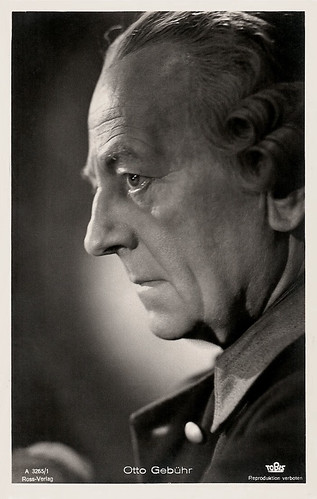
German postcard by Ross Verlag, no. A 3265/1, 1941-1944. Photo: Tobis.
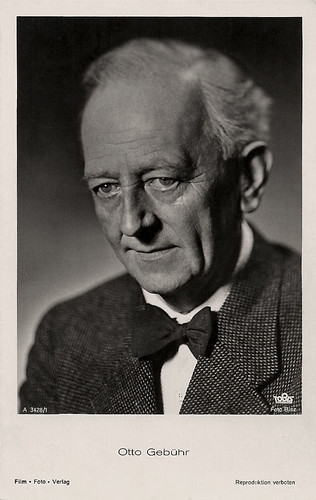
German postcard by Film-Foto-Verlag, no. A 3428/1, 1941-1944. Photo: Binz / Tobis.
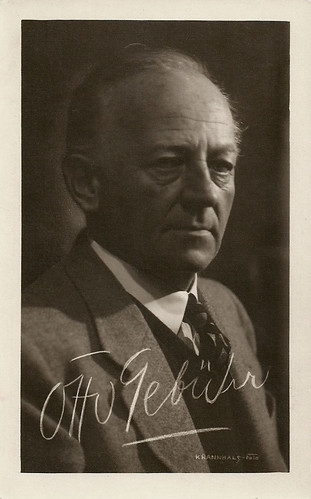
German postcard. Photo: Krannhals.
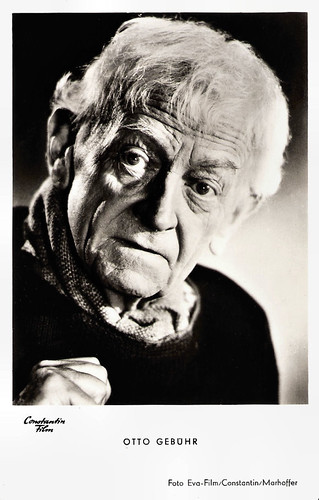
German postcard by Kunst und Bild, Berlin, no. A 1098. Photo: Eva-Film / Constantin / Marhoffer. Publicity still for Rosen-Resli/Rose-Girl Resli (Harald Reinl, 1954).
Sources: Thomas Staedeli (Cyranos), Wikipedia (German), Deutsches Historisches Museum (German), and IMDb.
This post was last updated on 10 May 2024.

German postcard by W.J. Morlins / Ross Verlag, no. 647/2. Photo: Karl Schenker. Publicity still for Fridericus Rex (Arzén von Cserépy, 1921). Fridericus Rex was a four-part series with Otto Gebühr as King Frederick II as Crown Prince in part I and II.

German postcard by Ross Verlag, no. 651/2. Otto Gebühr as crown prince Frederick (future Frederick II) and Lilly Alexander as Doris Ritter in Fridericus Rex (Arzen von Cserépy, 1921-1922).

German postcard by Ross Verlag. Photo: Fox. Otto Gebühr as King Frederick the Great in the German silent film Die Mühle von Sanssouci/The Mill of Sanssouci (Friedrich Zelnik, Siegfried Philippi, 1926).

German postcard by Ross Verlag, no. 3185/2, 1928-1929. Photo: National. Publicity still for Der alte Fritz/The Old Fritz (Gerhard Lamprecht, 1928).

German postcard by Ross Verlag, no. 125/1. Photo: Ufa. Otto Gebühr as Frederick the Great in Das Flötenkonzert von Sanssouci/The Flute Concert of Sans-Souci (Gustav Ucicky, 1930).

German postcard by Ross Verlag, no. A 3326/1, 1931-1944. Photo: Tobis. Publicity still for Der große König/The Great King (Veit Harlan, 1942).
The King of Prussia
Otto Gebühr was born in Kettwig (now Essen), Germany in 1877. He was the son of merchant Otto Gebühr and his wife Fanny Mathilde Moll. He grew up in Hülsenbusch, a part of Gummersbach, and, after his father’s death, in Köln (Cologne).
After attending grammar school he had a trade training at a wool firm. In 1896 he worked as a correspondent in foreign languages for a firm in Berlin, but he also had acting classes. For a while, he then worked as a strolling actor till he got a contract at the Stadttheater Görlitz.
From 1898 to 1908, he worked at the Königlichen Hoftheater in Dresden, and till 1914 at the Lessingtheater and the Theater in der Königgrätzer Straße, both in Berlin. During the First World War, he was an army volunteer for the field artillery regiment and became a second lieutenant. After this, he worked from 1917 to 1919 for famous director Max Reinhardt at the Deutschen Theater in Berlin.
At the same time, he began to appear in silent films. His film debut was Der Richter/The Judge (Hans Land, 1917) for the Messter company. Gebühr was a look-a-like of King Friedrich II (1712-1786). Introduced by his colleague Paul Wegener, director Carl Boese cast him as the King of Prussia in the silent film Die Tänzerin Barberina/The Dancer Barbarina (Carl Boese, 1920). The role would become his breakthrough. He would play Friedrich several times, but initially in the very successful, four-part film series Fridericus Rex (1920-1923).
To his other well-known silent films belong the crime film Whitechapel (Ewald André Dupont, 1920), the worldwide success Der Golem, wie er in die Welt kam/The Golem: How He Came Into the World (Carl Boese, Paul Wegener, 1920), Wilhelm Tell (Rudolf Dworsky, Rudolf Walther-Fein, 1923), Die Perücke/The Wig (Berthold Viertel, 1925), Die Gesunkenen/The Sunken (Rudolf Walther-Fein, Rudolf Dworsky, 1925), and Waterloo (Karl Grune, 1929).

German postcard by Ross Verlag, Berlin, no. 651/4, sent by mail in 1922. Photo: Cserépy-Film Co. Still for Fridericus Rex (1921).

German postcard by Ross Verlag, Berlin, no. 651/8, sent by mail in 1922. Photo: Cserépy-Film Co. Still for Fridericus Rex (1922) with Lili Flohr.

German postcard by Ross Verlag, no. 51/9. Photo: Fox. Otto Gebühr as King Frederick the Great in Die Mühle von Sanssouci/The Mill of Sanssouci (Friedrich Zelnik, Siegfried Philippi, 1926).

Austrian postcard by Iris Verlag, no. 450. Photo: Fox Film.

German postcard by Eiko Film / National-Film A.G., Berlin. Photo: Eiko Film / National. Publicity still for In treue stark/In faithful strong (Heinrich Brandt, 1926). Caption: Otto Gebúhr as commander of the Line Ship Heffen.

Austrian postcard by Iris Verlag, no. 816. Photo: National Film / Mondial AG. Otto Gebühr in the German silent film Die Sporck'schen Jäger (Holger-Madsen, 1926).

German postcard by W.J. Morlins, Berlin / Ross Verlag, Berlin, no. 647/11. Photo: Karl Schenker / Cserépy-Film Co. Otto Gebühr as Friedrich II in Der Alte Fritz/The Old Fritz (Gerhard Lamprecht, 1928).
First National Socialist
After the introduction of the sound film, Otto Gebühr again had a huge success as the King of Prussia in Das Flötenkonzert in Sanssouci/The Flute Concert of Sans-Souci (Gustav Ucicky, 1930). He repeated his role in the remake of Die Tänzerin von Sanssouci/Barberina (Friedrich Zelnik, 1932) at the side of Lil Dagover and Hans Stüwe.
Gebühr was the cinematic incarnation of the heroic Prussian, and his type was popular during the Third Reich. Gebühr was a voluntary pawn in the propaganda machine of the Nazis and appeared in several films, including Fridericus (Johannes Meyer, 1937) with Lil Dagover, as the ‘First National Socialist’, as propaganda minister Joseph Goebbels had called him.
In 1938 Goebbels gave Gebühr the title 'Staatsschauspieler' (Actor of the State). He was then one of the four highest-paid and most famous actors in Germany - the others were Heinz Rühmann, Hans Albers and Heinrich George. Among his entertainment films were big hits such as Der Choral von Leuthen/The Anthem of Leuthen (Carl Froelich, Arzén von Cserépy, 1933) with Olga Tschechova, Nanon (Herbert Maisch, 1938) with Johannes Heesters, and Casanova heiratet/Casanova Marries (Viktor de Kowa, 1939).
Some of his roles, like Blücher in Waterloo (Karl Grune, 1928) and the King of Saxony in Bismarck (Wolfgang Liebeneiner, 1940), had the same authoritative features as Friedrich II. He again appeared as Friedrich II in Veit Harlan’s epic Der große König/The Great King (Veit Harlan, 1942).
Till the end of the Third Reich, he appeared in more light entertainment films like Immensee (Veit Harlan, 1943) starring Kristina Söderbaum and Carl Raddatz, Die goldene Spinne/The Golden Spider (Erich Engels, 1943), and Der Erbförster/The Hereditary Forester (Alois Johannes Lippl, 1945).

German postcard by Ross Verlag, no. 1067/1, 1927-1928. Photo Alex Binder.

German postcard by Ross Verlag, no. 1960/1, 1927-1928. Photo: National.

German postcard by Ross Verlag, no. 3352/1, 1928-1929. Photo: National.

German postcard by Ross Verlag, no. 3875/1, 1928-1929. Photo: Emelka. Publicity still for Waterloo (Karl Grune, 1928), in which Gebühr played General/Fieldmarshall Blücher and Frederick the Great. Here he is dressed as Blücher.

German postcard by Ross Verlag, no. 4052/1, 1929-1930. Photo: Anton Sahm, München.

Austrian postcard by Iris Verlag, no. 738. Photo: Treuhand-Film / Mondial A.G. / National. Publicity still for Scapa Flow (Leo Lasko, 1930) with Claire Rommer.

German postcard by Ross Verlag, no. 125/6. Photo: Ufa. Otto Gebühr as Frederick the Great in Das Flötenkonzert von Sanssouci/The Flute Concert of Sans-Souci (Gustav Ucicky, 1930). This picture is a literal citation of the famous painting Flötenkonzert Friedrichs des Großen in Sanssouci (1850-52) by Adolph (von) Menzel, now at the Alte Nationalgalerie in Berlin.
Heimatfilms
From 1947 on, Otto Gebühr was permitted to work again in the theatre. His first post-war film was the drama ...und über uns der Himmel/...and the Sky Above Us (Josef von Báky, 1947) starring Hans Albers.
Till his death, he appeared in many entertainment films. He often played the odd companion or the cheerful senile maverick in such Heimatfilms as Melodie des Schicksals/Melody of Destiny (Hans Schweikart, 1950) with Brigitte Horney, and Grün ist die Heide/The Heath Is Green (Hans Deppe, 1951) starring Sonja Ziemann and Rudolf Prack.
Again he also appeared under the direction of Veit Harlan in Unsterbliche Geliebte/Immortal Beloved (1951) with Kristina Söderbaum.
His final film was Die Blonde Frau des Maharadscha/The Blonde Wife of the Maharadja (Veit Harlan, 1962) – a new version of Die Gefangene des Maharadscha/Circus Girl (Veit Harlan, 1954). The film was released eight years after his death.
Otto Gebühr died of heart failure in 1954, in Wiesbaden, Germany. He was twice married. In 1910 he married Cornelia Bertha Julius, with whom he had a daughter, actress Hilde Gebühr. His second wife was actress Doris Krüger, with whom he was married from 1942 till her death in 1950. They had a son, Prof. Dr. Michael Gebühr.

German postcard by Ross Verlag, no. 5444/3, 1930-1931. Photo: Ufa. Otto Gebühr as Friedrich II in Das Flötenkonzert von Sanssouci (Gustav von Ucicky, 1930).

German postcard by Ross Verlag, Berlin, no. 5663/11, 1930-1931. Photo: Ufa.

German postcard by Ross Verlag, no. A 3098/1, 1941-1944. Photo: Tobis.

German postcard by Ross Verlag, no. A 3265/1, 1941-1944. Photo: Tobis.

German postcard by Film-Foto-Verlag, no. A 3428/1, 1941-1944. Photo: Binz / Tobis.

German postcard. Photo: Krannhals.

German postcard by Kunst und Bild, Berlin, no. A 1098. Photo: Eva-Film / Constantin / Marhoffer. Publicity still for Rosen-Resli/Rose-Girl Resli (Harald Reinl, 1954).
Sources: Thomas Staedeli (Cyranos), Wikipedia (German), Deutsches Historisches Museum (German), and IMDb.
This post was last updated on 10 May 2024.
No comments:
Post a Comment